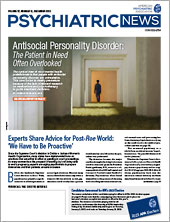Inpatient psychiatrists are familiar with patients who refuse to take a shower. My first encounter with the issue occurred within one week of resuming work on a long-stay inpatient unit. I witnessed a struggling and screaming patient being dragged into the shower by six burly staff members, two from the same unit and four from other units. It was a chaotic (and rather dangerous) scene. I was later informed that the patient had not taken a shower in two months, and other patients on the unit were beginning to complain about sharing common space with him. The decision to embark on this drastic action was by no means unanimous among staff; some were upset with the indignity of a grown man being forcibly showered, stating that everyone had the right to choose when to shower. Supporters of the decision to shower him noted that he smelled of urine and often sat in the day room on communal chairs; they also pointed out old and new food stains on the patient’s clothes, now mixed with fecal material, because the patient had also refused to change his clothes. A greater debate on these concerns ensued.
A similar situation arose on another psychiatrist’s unit when lice were discovered on the dreadlocks of an African American woman patient. The patient’s parents and her conservator reported that her hair was her pride and she had been grooming and maintaining it for years before becoming increasingly seriously psychiatrically ill. Her illness had been so severe that she had stopped grooming herself and had been homeless for weeks at a time, which explained her lice infestation. As soon as lice were discovered, she was immediately placed in a single room, but she stayed there for only short periods, preferring to stay in the dayroom with her peers. This caused great alarm as staff were worried of widespread lice infestation.
Inpatient units of psychiatric hospitals are often tight spaces shared by many patients in a congregate setting. They share common room areas, unit amenities, food, and even bedrooms. Depending on the nature of the inpatient unit, or of a particular patient’s illness, some patients may not be able to leave the unit at will and may be confined to the unit for days or more at a time.
In the two situations described above, staff were confronted with conflicting ethical obligations—the right of a patient to privacy, autonomy, dignity, and respect with the right of the unit community to be free from noxious elements. Also, staff have an ethical obligation to protect individuals afflicted with loss of contact with reality from their psychotically driven behaviors (such as poor self-care) that could be harmful to them. In practical terms, therefore, it is acceptable for a patient to refuse to shower or to change clothes for as long as possible, even months, despite the discomfort of staff and the patient’s peers as long as it does not negatively impact the patient’s health, the rights of others to clean air and sanitary unit conditions, and the right to be free from disease.
As most of these behaviors are driven by a complex mixture of psychosis and trauma, optimization of psychotropic medication treatment is paramount, with the hope that restoration of a patient’s insight will lead to an awakening and a return of prosocial behavior. However, recovery could take months or even years; therefore, staff need to act before that happens. I recommend a graded process from least invasive to more invasive interventions.
In the early stages, the patient should be gently encouraged to take a shower and or change clothes, employing the help of the patient’s friends and family, if available, and trusted staff members. Negotiating with the patient includes offering to provide the patient’s desired activities or food in exchange for taking the desired behavior. If the patient agrees to put on clean clothes but still refuses to shower, staff should determine whether that is sufficient for the moment—are the patient and others now safe from germs/medical ailments?
Forcibly leading a patient to the shower room should be the absolute last option as it may trigger trauma reactions because many psychiatric patients (up to 90%) have been exposed to trauma. Therefore, re-enactment of trauma could cause a patient to react with violence that may necessitate placement in mechanical restraints. The patient’s family, conservator, or legal advocates should be informed about the planned action in advance and the risks of violence and restraints. Forcible action should therefore be undertaken only when the risk of disease to the patient or the community surpasses the risk of potentially re-traumatizing the patient.
For the patient with head lice, after much encouragement and “bribery” with her favorite meal, she grudgingly agreed to application of an anti-lice cream recommended by infectious disease professionals, but she would not allow the application of the cream to the extent needed to be completely free of infestation. Experts recommended shaving her head as the only option. Multiple discussions were had with her conservator, family, close friend, key members of her community, and even her pastor to no avail. These discussions reflected staff’s deep respect for the patient. The probate court judge authorized the conservator to approve whatever measures were needed to ensure the safety of the patient and community. Discussions then revolved around how to shave her head in a humane manner. No one was happy with this outcome, not the patient or the staff; it was the option of last resort to achieve safety.
In conclusion, balancing ethical conflicts and individual versus community rights on an inpatient unit can be daunting. Although drastic measures may be needed to keep everyone safe, they should be carried out with much planning and coordination with the patient, family, conservator, and legal advocate after less intrusive or invasive measures have failed. ■

